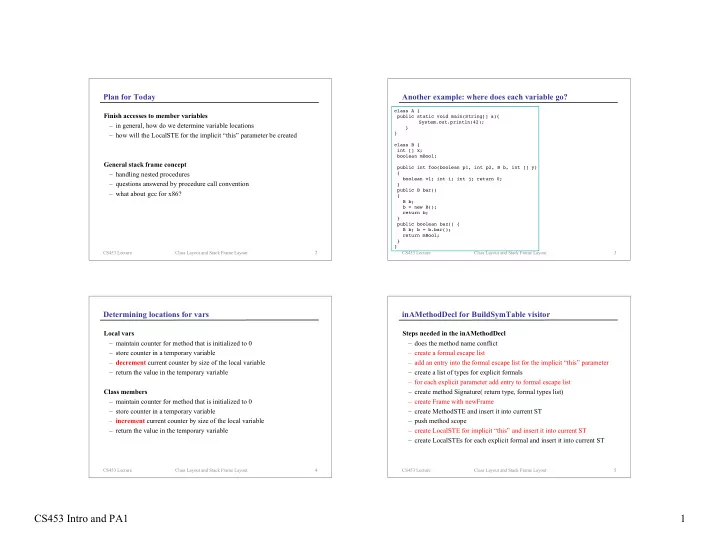

Plan for Today Another example: where does each variable go? class A { Finish accesses to member variables public static void main(String[] a){ System.out.println(42); – in general, how do we determine variable locations } – how will the LocalSTE for the implicit “this” parameter be created } class B { int [] x; boolean mBool; General stack frame concept public int foo(boolean p1, int p2, B b, int [] y) – handling nested procedures { boolean v1; int i; int j; return 0; – questions answered by procedure call convention } public B bar() – what about gcc for x86? { B b; b = new B(); return b; } public boolean baz() { B b; b = b.bar(); return mBool; } } CS453 Lecture Class Layout and Stack Frame Layout 2 CS453 Lecture Class Layout and Stack Frame Layout 3 Determining locations for vars inAMethodDecl for BuildSymTable visitor Local vars Steps needed in the inAMethodDecl – maintain counter for method that is initialized to 0 – does the method name conflict – store counter in a temporary variable – create a formal escape list – decrement current counter by size of the local variable – add an entry into the formal escape list for the implicit “this” parameter – return the value in the temporary variable – create a list of types for explicit formals – for each explicit parameter add entry to formal escape list Class members – create method Signature( return type, formal types list) – maintain counter for method that is initialized to 0 – create Frame with newFrame – store counter in a temporary variable – create MethodSTE and insert it into current ST – increment current counter by size of the local variable – push method scope – return the value in the temporary variable – create LocalSTE for implicit “this” and insert it into current ST – create LocalSTEs for each explicit formal and insert it into current ST CS453 Lecture Class Layout and Stack Frame Layout 4 CS453 Lecture Class Layout and Stack Frame Layout 5 CS453 Intro and PA1 1
Nested Procedures Example Nested Procedures Suggested Exercise int foo(int x) float E(float x) { { int baz(int y) { float F(float y) return x+y; { } if (y<=0) { int bar() { return baz(2); return 1; } } else { } return x + F(y-1); int main() { printf(“%f\n”, E(4)); } } return F(2); } What is the output of the above program? int main() { Draw the stack frame using static links. printf(“%f\n”, E(4)); } CS453 Lecture Class Layout and Stack Frame Layout 6 CS453 Lecture Class Layout and Stack Frame Layout 7 Questions a calling convention must answer funcCall1.c int foo(int x,int y,int *z) { Contract between caller and callee int a; – Where is the return value? a = x * y - *z; return a; – Where is the stack pointer pointing upon entry to a function? } – Where are the parameters? int main() { – Is the caller or callee responsible for popping the parameters? int x; x = 2; – Does the stack pointer point at the top of the stack or the next empty slot? x = foo(4,5,&x); return x; } Decisions needed for manipulating a frame/activation record – Layout of callee-saved registers, caller-saved registers, locals, and temps – Are parameters pushed by moving the stack pointer or is enough space set aside initially? CS453 Lecture Class Layout and Stack Frame Layout 8 CS453 Lecture Class Layout and Stack Frame Layout 9 CS453 Intro and PA1 2
Suggested Exercise: funcCall1.c for x86 foo: main: pushl %ebp leal 4(%esp), %ecx movl %esp, %ebp andl $-16, %esp subl $16, %esp pushl -4(%ecx) movl 8(%ebp), %eax pushl %ebp movl %eax, %edx movl %esp, %ebp imull 12(%ebp), %edx pushl %ecx movl 16(%ebp), %eax subl $28, %esp movl (%eax), %eax movl $2, -8(%ebp) movl %edx, %ecx leal -8(%ebp), %eax subl %eax, %ecx movl %eax, 8(%esp) movl %ecx, %eax movl $5, 4(%esp) movl %eax, -4(%ebp) movl $4, (%esp) movl -4(%ebp), %eax call foo leave movl %eax, -8(%ebp) ret movl -8(%ebp), %eax addl $28, %esp What register holds the stack pointer? popl %ecx frame pointer? the return value? popl %ebp leal -4(%ecx), %esp In instructions, where are source and dest? ret How is the local variable “a” accessed? CS453 Lecture Class Layout and Stack Frame Layout 10 CS453 Intro and PA1 3
Recommend
More recommend